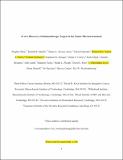In vivo discovery of immunotherapy targets in the tumour microenvironment
Author(s)
Zhou, Penghui; Shaffer, Donald R.; Alvarez Arias, Diana A.; Nakazaki, Yukoh; Pos, Wouter; Torres, Alexis J.; Cremasco, Viviana; Dougan, Stephanie K.; Cowley, Glenn S.; Elpek, Kutlu; Brogdon, Jennifer; Lamb, John; Turley, Shannon J.; Ploegh, Hidde; Root, David E.; Dranoff, Glenn; Hacohen, Nir; Cantor, Harvey; Wucherpfennig, Kai W.; Love, John C; ... Show more Show less
DownloadPloegh.pdf (832.6Kb)
PUBLISHER_POLICY
Publisher Policy
Article is made available in accordance with the publisher's policy and may be subject to US copyright law. Please refer to the publisher's site for terms of use.
Terms of use
Metadata
Show full item recordAbstract
Recent clinical trials showed that targeting of inhibitory receptors on T cells induces durable responses in a subset of cancer patients, despite advanced disease. However, the regulatory switches controlling T-cell function in immunosuppressive tumours are not well understood. Here we show that such inhibitory mechanisms can be systematically discovered in the tumour microenvironment. We devised an in vivo pooled short hairpin RNA (shRNA) screen in which shRNAs targeting negative regulators became highly enriched in murine tumours by releasing a block on T-cell proliferation upon tumour antigen recognition. Such shRNAs were identified by deep sequencing of the shRNA cassette from T cells infiltrating tumour or control tissues. One of the target genes was Ppp2r2d, a regulatory subunit of the PP2A phosphatase family. In tumours, Ppp2r2d knockdown inhibited T-cell apoptosis and enhanced T-cell proliferation as well as cytokine production. Key regulators of immune function can therefore be discovered in relevant tissue microenvironments.
Date issued
2014-01Department
Massachusetts Institute of Technology. Department of Biology; Massachusetts Institute of Technology. Department of Chemical EngineeringJournal
Nature
Publisher
Nature Publishing Group
Citation
Zhou, Penghui, Donald R. Shaffer, Diana A. Alvarez Arias, Yukoh Nakazaki, Wouter Pos, Alexis J. Torres, Viviana Cremasco, et al. “In Vivo Discovery of Immunotherapy Targets in the Tumour Microenvironment.” Nature 506, no. 7486 (January 29, 2014): 52–57.
Version: Original manuscript
ISSN
0028-0836
1476-4687